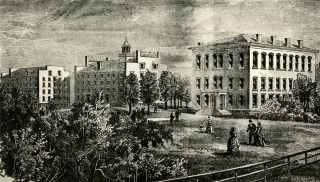time winked at accepting those whose qualifications were doubtful. One alumnus of the Class of 1854 recalled:
We had students of every eligible age and previous condition of servitude, green blades and stubs; some with bald heads and corrugated cheeks, nearly fifty years old; some who couldn’t get a lesson; some who preached about as often as they recited and who used the name of the institution as a password rather than its facilities for qualifying themselves. The classes were medleys, not homogeneous. When students came from other institutions they were accorded class standings on ‘courtesy’ without examination.*
He also commented that some of the Seminary men tried to substitute “piety”
for studies and outranked the smaller but growing number of “aliens,”
or non-ministerial students. Returning from supplying in the churches, “jingling their pockets and sporting a gold watch or a set of furs,”
the theologues excited the resentment of poverty-stricken “aliens”
who, had to rely for their money on selling books or other vacation jobs.
Annual expenses for undergraduates rose from $93 in 1850 to $168 in 1869. The increase is explained principally by the rising cost of board-$1.25 per week in 1850 and $3.00 from 1864 to 1869. “Incidental Expenses” also advanced from $3.00 to $8.00, but tuition remained at $30.00, room rent at $9.00, and sacred music at $1.00. For students in the College who were preparing to preach, room rent was free. Seminary students likewise paid no room rent and, in addition, received their tuition; their other expenses were the same as those in the College. For the Grammar School, fees were identical with those in the College except for the lower tuition of $20.00. It was estimated in 1868 that a student could live “very comfortably and even genteely for about $250.”
The Stewards and their wives appear to have been successful in satisfying student appetites. There were mild objections to the frequency of “donation mutton”
or dried cod fish, but one alumnus from the Class of 1856 recalled with pleasure “the plain yet toothsome hospitality”
dispensed at the amazing low price of $1.25 per week and the clean dining room with its throngs of hungry yet gay and cheerful”
boarders. The menus included flapjacks, molasses, potatoes, and coffee for breakfast, meat and apple pie at noon; and bread and butter, apple sauce, cookies and tea for supper.
* Madisonensis (Apr. 24, 1886), 176.





